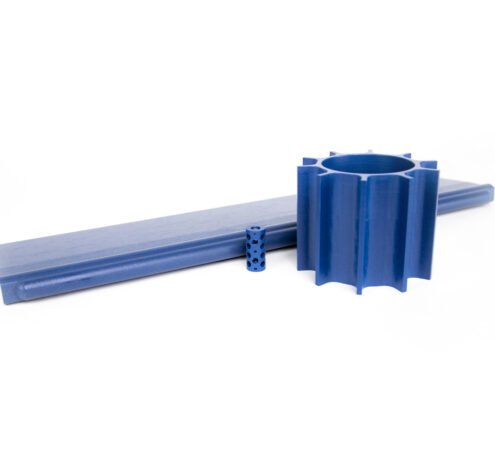Acetal Copolymer Ultra Detectable

Acetal Copolymer Ultra Detectable Overview
What is the Material: Acetal Copolymer Ultra Detectable is a semi-crystalline material and it is a modified acetal copolymer filled with a multi-detectable filler.
Key Material Features: This material is beneficial in applications requiring increased food safety, while maintaining many benefits of other acetal copolymer materials including high mechanical strength, rigidity, excellent wear, low moisture absorption, and dimensional stability.
Other Considerations: The detectable filler makes the material detectable using x-ray imaging, metal detection, and by optical scanners. Nylon materials typically perform better than acetal materials in abrasive wear applications.
Physical
| Property | Value | Typical ASTM Test |
|---|---|---|
| Chemical Designation | (POM-C) Polyoxymethylene Copolymer | |
| Trade Names (®, ™) | Tecaform UD | |
| Filler | Detectable Filler | |
| Color | Dark Blue | |
| Density (g/cm^3) | 1.71 | D 792 |
Mechanical
| Property | Value | Typical ASTM Test |
|---|---|---|
| Modulus of Elasticity (Tensile Test) (psi) | 300000 | D 638 |
| Tensile Strength at Yield (psi) | 7500 | D 638 |
| Elongation at Break (%) | 12 | D 638 |
| Flexural Strength (psi) | 12500 | D 790 |
| Modulus of Elasticity (Flexural Test) (psi) | 460000 | D 790 |
| Compression Strength: 10% Strain (psi) | 12650 | D 695 |
| Compression Strength: 1% Strain (psi) | 1600 | D 695 |
| Compression Modulus (psi) | 240000 | D 695 |
| Impact Strength (Izod) (ft-lbs/in) | 0.68 | D 256 |
| Hardness (M) | 89 | D 785 |
Thermal
| Property | Value | Typical ASTM Test |
|---|---|---|
| Melting Point (°F) | 329 | D 3418 |
| Deflection Temperature (°F) (66 psi) | 320 | D 648 |
| Deflection Temperature (°F) (264 psi) | 230 | D 648 |
| Service Temperature Continuous (°F) | 212 | |
| Service Temperature Intermittent (°F) | 285 | |
| Thermal Expansion (CLTE) (in/in/°F) | 1.20E-5 | D 696 |
Electrical
| Property | Value | Typical ASTM Test |
|---|---|---|
| Volume Resistivity (Ω*cm) | 1.00E14 | D 257 |
Other
| Property | Value | Typical ASTM Test |
|---|---|---|
| Moisture Absorption (%) (24 Hours) | 0.13 | D 570 |
The data stated are typical values intended for reference and comparison purposes only. The data should not be used as a basis for design specifications or quality control. The information is provided as a guide to the best of our knowledge and given without obligation or liability. Testing under individual application circumstances is recommended.
